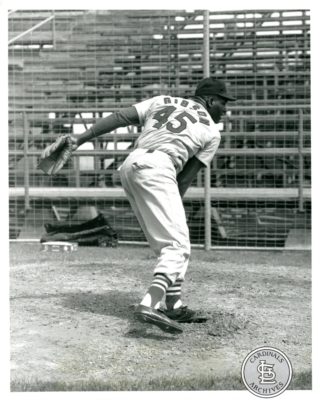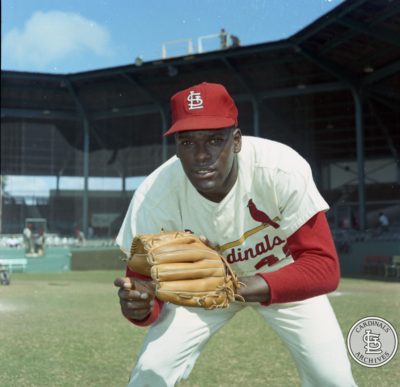Sixty years ago – June 8, 1962 – the St. Louis Cardinals beat the San Francisco Giants, 8-4, at Busch Stadium in the first of a four-game weekend series.
The result was insignificant; the Cardinals finished in sixth place in the National League that season and the setback did not stop the Giants’ march to the pennant.
But with six decades of hindsight, the game offered 16,209 fans in attendance glimpses into the Cardinals’ future and past – and it offers us a chance to relive a team and city on the brink of transformation.
Harry Caray and Jack Buck called the action on KMOX; the broadcast is now public domain and available in its’ entirety. The accounts of the game are taken from that audio recording.
Caray and Buck are masterful and the 1960’s era advertisements for dual-filtered Tareyton cigarettes and Busch Bavarian beer are charmingly funny. You can find the broadcast on YouTube and the Internet Archive.
Amy Berra, curator of the Cardinals’ Hall of Fame and Museum, provided additional source material and photos for this story – I am grateful to her and the Museum for their help.
To paraphrase Mike Shannon – a 22-year-old rookie that wore No. 60 at Spring Training in 1962 – I hope you enjoy reading this as much as I enjoyed bringing it to you.
Caray: “Here now is Willie McCovey – too big to be a man and not quite big enough to be a horse. McCovey, born in Mobile, Alabama; his hobby is reading comic books and seeing motion pictures.”
Buck: “And hitting.”
Caray: “Yeah.”
The Giants were the class of the National League in 1962. San Francisco won 103 games and pounded opposing pitchers – leading the league in team batting average, home runs and runs scored.
Glaring at McCovey from the mound was Cardinals’ starting pitcher Bob Gibson.
The 26-year-old righthander had just frozen Giants’ center fielder Willie Mays with a sweeping curveball and McCovey – who entered the game 9-for-19 against Gibson with a home run – was all that stood between the Cardinals and a painless opening frame.
Caray: “Now the wind-up, the 2-2 delivery to McCovey – barely missed outside and Gibson is furious about that one. Three balls, two strikes.”
Buck: “He was really moaning about the second pitch to McCovey. The umpire didn’t give it to him. He threw the 2-2 pitch in the very same spot and (home plate umpire Paul) Pryor still wouldn’t give it to him.”

Photo courtesy of Cardinals Archives
Gibson would later call McCovey the scariest hitter in baseball, but at the time the trajectory of his own career was uncertain.
The one-time Harlem Globetrotter issued a National League-worst 119 walks in 1961, then stumbled to a 6.11 ERA in the first month of the season. But he’d found a groove lately and posted five wins in May to improve his career mark to 25 wins and 27 losses.
Caray: “Now it’s a 3-2 pitch again, here it is on the way – lined into center a base hit and now Gibson is really angry – even more angry, as that ball sailed past his head into center, he was already barking at Paul Pryor, as if to say, well if you give him that many strikes, sure he’s going to get a hit sooner or later.”
Gibson’s fiery demeanor on the mound would personify the coming decade of Cardinals’ baseball.
The fans that filed into Busch Stadium, more commonly known as Sportsman’s Park, were undeterred by strong thunderstorms that drenched St. Louis that afternoon.
A group from a bowling alley in Belleville, Illinois that was part-owned by Red Schoendienst were in attendance; so was a contingent from West Plains High School, located 200 miles away in south-central Missouri.
The aging structure on North Grand Avenue and Dodier Street was completed in 1909 and plans were underway for a state-of-the-art multipurpose stadium on the riverfront – just one of many projects that would soon change the St. Louis’ horizon and usher the city, planners hoped, into a new age of progress.
The foundation of the Gateway Arch was being laid that summer and the first steel triangles were still months away from starting their journey skyward.
With the game scoreless in the second inning, Cardinals’ shortstop Julio Gotay singled with two outs, bringing right fielder Doug Clemens to the dish.
Caray: “Now (Juan) Marichal steps off the rubber…two balls and a strike, Gotay a lead – and the pitch, there’s a high flyball to center that will be an easy out – Willie Mays can’t find it!”
“It drops for a hit – here’s Clemens around to third, the run scores! And he’s in there with a triple!”
“Willie Mays lost the ball in the lights, couldn’t locate it at all. Standing there – and he suddenly looked over toward Felipe Alou, as if to say, ‘where is it, Felipe?’”
“Get a good look at that because boy, you don’t see that happen often.”
Even with help from Mays’ miscue, Clemens batted for a .217 average in 93 games with St. Louis. Two years later, the Cardinals traded him and two others to the Chicago Cubs for Lou Brock.
That day in Chicago, Brock collected two hits to help the Cubs split a double-header with the lowly New York Mets at Wrigley Field.
Those clubs met again nine days later at the Polo Grounds in Manhattan, and Brock blasted a home run off Mets’ starter Al Jackson that traveled more than 460-feet and sailed into the ancient bleachers in center field.
Brock was just the fourth player to hit a homer that reached those seats, and only the second player in the history of the Polo Grounds to do it during a Major League game.
The next day, Milwaukee Braves’ outfielder Henry Aaron would be the last to accomplish that feat.
Buck: “Well a reminder right here, fans, that the 1962 edition of the dual-filtered Tareyton Baseball Guide is available. For your copy, send 50 cents with your name and address to Harry Caray, care of the Sporting News, Box 5-6, St. Louis, Missouri. Send for your copy this evening and have it for the remainder of the season to enjoy.”
37-year-old Jack Buck was in his second tour-of-duty in the KMOX booth – one that would last until he stepped away 39 years later. He rejoined partners’ Caray and Joe Garagiola in 1961 after Buddy Blattner bumped him from the crew the year before.
1962 was Garagiola’s final season as a member of the Cardinals’ trio of Hall of Fame voices. He would enjoy a long career on radio and television with NBC; in addition to broadcasting baseball, he co-hosted the Today show and guest-hosted for Johnny Carson.
As the Washington Post wrote upon his death in 2016, Garagiola – a St. Louisan that was childhood friends with Yogi Berra, played parts of six seasons with the Cardinals and married the team’s organist at Sportsman’s Park in 1949 – made one of his first television appearances at a 1960 presidential campaign rally for John F. Kennedy.
Standing by Kennedy and former president Harry Truman, Garagiola quipped to his dad watching at home, “Hey Pop, I just want you to see who I’m hanging around with.”
In Washington, D.C. on June 8, 1962, President Kennedy awarded three teenagers with medals for volunteerism and met with dignitaries from Germany.
Somewhere in the Atlantic Ocean, a Dutch cruise liner was ferrying Lee and Marina Oswald and the couple’s infant daughter to New York City – the final leg of a journey from the Soviet Union.
Elsewhere on the seas, Soviet nuclear missiles were bound for Cuba. The day before the Giants lost to the New York Yankees in Game 7 of the 1962 World Series, Kennedy would learn of the threat and one of the most intense episodes of the Cold War began.
Gibson faced the heart of the Giants’ order again in the third inning.
Caray: “Mays the batter, one out and one on…Bob Gibson with a one-run lead, into the stretch, the 3-1 pitch, here it is: And there it goes. Way back it might be out of here, it could be, it is!
“A home run into right-center, his 20th home run of the year.”
“So, Willie gave us one run and just got two back. Mays hit a 3-1 pitch into the right-center field pavilion and the Giants, just like that, lead 2-1. And you almost knew that was going to happen.”
The next batter, McCovey, got ahead in the count, then took a big swing at a Gibson fastball but missed.
Caray: “Man these guys – these guys really get some cuts!” he said, laughing. “One ball, one strike – now the delivery, there she goes! Way back, forget about it. Home run.”
“He even broke the bat and hit it on the roof. A line drive, and the Giants lead 3-1.”
Cardinals’ first baseman Bill White answered with a solo shot in the bottom of the third, and the Giants held a one-run lead into the fifth inning.
Gibson struck out Mays looking for the second time and he led-off the bottom of the fifth with a single, then moved to third on Julian Javier’s base hit.
White and Gibson’s place in Cardinals’ history was already secure in 1962, even if neither player accomplished anything else on the diamond.

Photo courtesy of Cardinals Archives
Along with outfielder Curt Flood, they were instrumental in the successful effort to integrate the Cardinals’ spring training accommodations in 1961. As White recounted in his autobiography published in 2011, he received a letter from Jackie Robinson afterwards, thanking him for everything he had done for Black baseball players.
Buck: “Outfield around to the right for Bill, hitting .269 with 10 home runs, 42 RBIs – a chance to make it 45 right here. One strike the count, here’s the pitch to him: Line drive into left-center field that’s a base hit and the ball game is tied, Javier is going to third base and there’s no play on him.”
“White gets his second hit, he really stroked that ball beautifully over the head of the shortstop Pagan into left-center, for his second run-batted-in of the night – driving in Gibson to tie the ballgame.”
Stan Musial hit into a fielder’s choice and Ken Boyer stepped-in with two runners on and two outs.
Boyer was a 7-time all-star, and the 31-year-old added two more All-Star game appearances to his total in 1962.
Buck: “Marichal taking his time. Nobody down in that Giants bullpen…runners lead away, here’s the pitch to Ken Boyer: a drive to very, very deep center field, Mays going back, way back near the bleachers – that ball is out of here!”
“Boyer wallops a three-run homer with two men out here in the fifth inning to put the Cardinals out in front, 6-3. That ball was really hit – about 430 feet…Mays chased it for a while, then stopped and watched it disappear into the bleacher customers out there.”
Boyer hit 24 home runs and drove-in 119 runs in 1964, earning National League MVP honors for the World Champion Cardinals. But he played through injuries in 1965 and St. Louis traded him to the New York Mets when the season ended.
In return, the Cardinals’ received pitcher Al Jackson, the victim of Brock’s historic blast at the Polo Grounds in June 1962.
Jackson won nine games for the 1967 championship team, but he was left off St. Louis’ World Series roster. He returned to New York and pitched for the 1969 “Miracle Mets” but was sold to the Cincinnati Reds mid-season.
Jackson pitched in 303 Major League games and contributed to two World Series winners, but he never threw a pitch in the postseason.
The Giants cut into the Cardinals’ advantage when Gibson surrendered a run in the seventh inning and Lindy McDaniel relieved him.
McDaniel retired Mays and McCovey with two runners aboard to preserve the Cardinals’ lead. He worked a perfect eighth inning too, striking out Orlando Cepeda and Jim Davenport.
White’s monster game continued when he singled off Giants’ reliever Don Larsen – famous for pitching a perfect game in the 1956 World Series – to score Flood in the bottom of the eighth. Musial was next, with runners at the corners and nobody out.
The 41-year-old Musial defied time in 1962, his 21st season wearing birds on the bat. He played in 135 games and hit for a .330 batting average with 19 home runs while rewriting the record books.
Three weeks earlier, on May 19 at Dodger Stadium, Musial passed Honus Wagner for most hits in National League history.
When his career ended, Stan joined a thriving St. Louis business community and in 1966, he belonged to the investment group that secured a National Hockey League expansion franchise for the city.
The St. Louis Browns left for Baltimore after the 1953 season, but Anheuser-Busch and Brown Shoe Company – the other two components of the famous line that described St. Louis as “first in shoes, first in booze and last in the American League” – were still dominant players in the region’s corporate landscape.
McDonnell Aircraft Corporation manufactured the Friendship 7 space capsule that took Mercury astronaut John Glenn on the first American orbital spaceflight in February 1962 – a mission critical to President Kennedy’s challenge for NASA to beat the Soviets in space.
The Western Cartridge Company in Alton, Illinois supplied the military with ammunition and produced the 6.5-millimeter bullet that Lee Oswald used to assassinate Kennedy the following year.
But while businesses looked forward with optimism, St. Louis’ leaders concerned themselves with reversing a population in decline.
St. Louis was America’s 10th-largest city, more populous than San Francisco, Boston, Dallas, Phoenix and Atlanta. But the 1960 census revealed an alarming 13 percent population drop in one decade.
That summer, city officials debated a proposed amendment to the Missouri constitution known as the Borough Plan – an attempt to expand St. Louis’ boundaries and consolidate many of the small municipalities into larger boroughs, like those in New York City.
But city planning troubles were far from the minds of the faithful at Busch Stadium, with the home team ahead – and as Gaylord Perry, a 23-year-old rookie and future Hall of Fame pitcher, limbered in the Giants’ bullpen – Musial stepped in to face Larsen.
Buck: “Javier and White, two good baserunners on – they lead away. Larsen to Musial, base hit into left! Another run scores on a single to left by Musial, and it’s 8-4.”
Musial was lifted for a pinch-runner and while applause echoed around the old ballpark, Buck paid tribute to Stan the Man.
“Harry, it’s still one of the prettiest sights in baseball to see Musial stroke that ball to the opposite field.”




